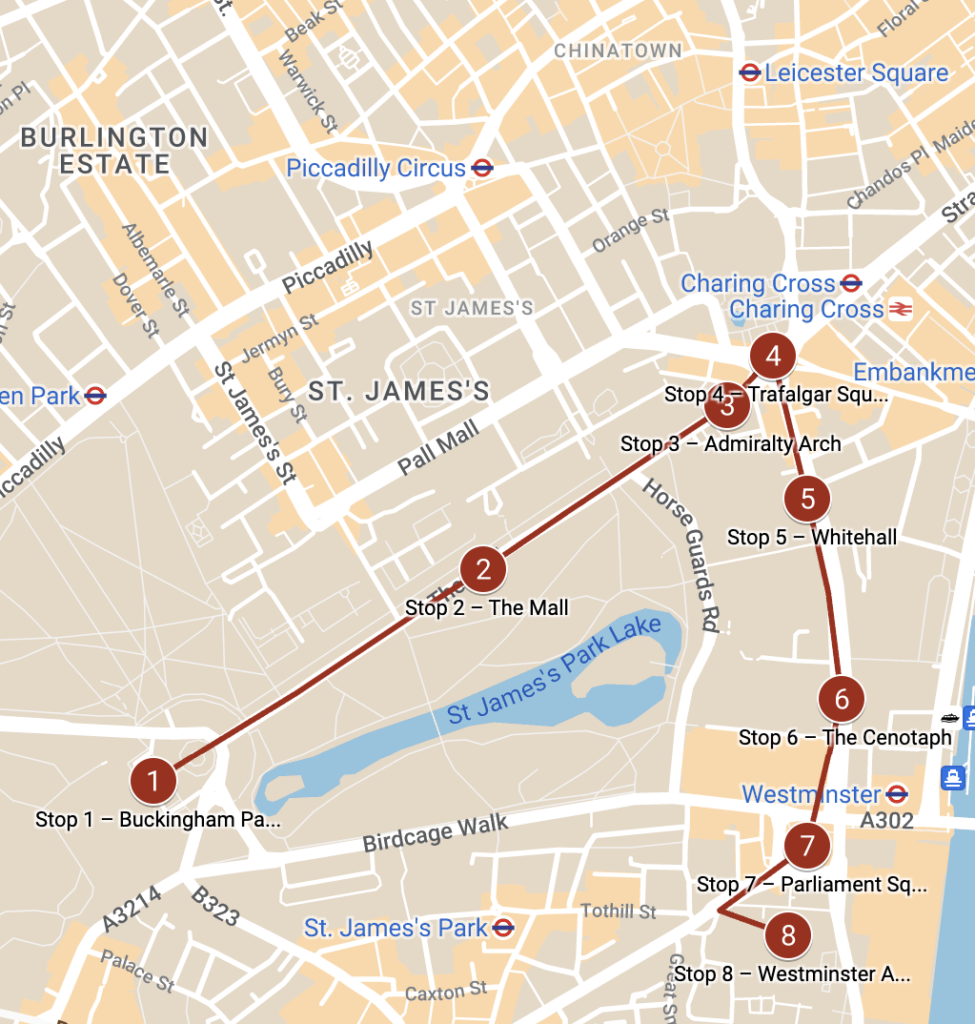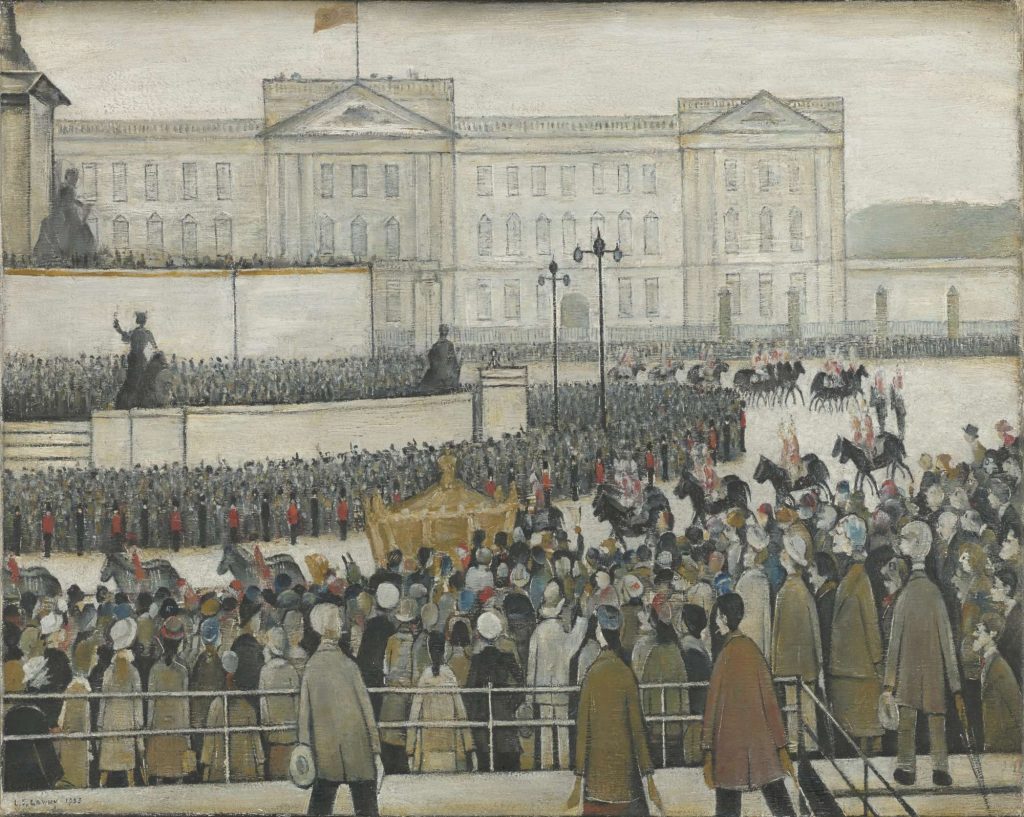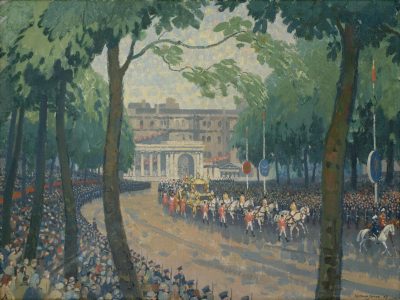Take a virtual tour of Queen Elizabeth II’s 1953 coronation
On Saturday 6 May, Their Majesties King Charles III and Queen Camilla left Buckingham Palace and followed a route taken by Queen Elizabeth II on her coronation procession in 1953. Whether you are in London or joining virtually at home, take a tour of Queen Elizabeth II's coronation procession through the eyes of major artists of the day. On this walk, we take in the excitement of the procession, starting with L.S. Lowry at Buckingham Palace and ending with Philippe Jullian's spectacular coronation sketches at Westminster Abbey.

On 2 June 1953, the Gold State Coach left Buckingham Palace and moved down the Mall, taking the Queen to Westminster Abbey. The return procession followed a route that was about 5 miles long, with three million spectators watching, through Whitehall, Trafalgar Square, Pall Mall, Hyde Park Corner, Marble Arch, Oxford Circus, and finally down the Mall to end at Buckingham Palace.
In our tour, we’ve selected some highlights of the route based on works in our Collection; whether you’re joining in virtually from home or recreating the walk in London yourself, learn more about each stop and the works we’ve selected by clicking the list below, and follow Queen Elizabeth II and King Charles III as they head to their coronation.
Your stops
-
1. Buckingham Palace
We start our tour at Buckingham Palace, much as the young Queen did in 1953 and King Charles III did in 2023. Crowds surrounded the Palace on the day of the coronation; amongst them, perched in a stand with a very good view, was L.S. Lowry.
I didn’t make any drawings at the time but went back the next morning and did a few, but, as I say, what I am going to paint I don’t yet know, but it will sort itself out.
-
2. The Mall
Crowds on the Mall were forced to hold up umbrellas to shield from the rain. According to the Met Office forecast for the day of the coronation:
A mostly cloudy day with rain or showers. A gentle to moderate north-westerly breeze. Maximum temperature well below average for early June.
-
3. Admiralty Arch

Bernard Phillip Batchelor, Coronation Preparations: Cleaning Admiralty Arch and Leonard Rosoman, The Coronation Procession in the Mall, from Admiralty Arch, 1953
Preparations for the coronation started 14 months before the ceremony. Admiralty Arch was a focal point of the Queen’s journey to Westminster Abbey, so it is no surprise that it had to be diligently cleaned. The Arch was also the perfect spot for artists like Leonard Rosoman (1913 – 2012) to capture the giant 17-foot arches decorating the Mall on the day.
-
4. Trafalgar Square
Banners waved in the air as crowds waited in Trafalgar Square. In Ebbe Sadolin’s drawings, the crowds are gathered around Nelson’s Column behind which guards stand to attention, while planes soar overhead in a tight military formation.
-
5. Whitehall
Special stands were erected for the day to seat the Royal Household, MPs, diplomatic corps and overseas visitors, among many others. They each held brightly coloured tickets telling them where to go. For the Mall it was green, Whitehall and Westminster red, Pall Mall gold, Piccadilly cerise, Hyde Park yellow, Oxford Street orange, and Regent Street and Haymarket blue.
-
6. Cenotaph
The State Coach journeyed past the Cenotaph, the First World War memorial that is the centre of activity for the National Service of Remembrance on Remembrance Sunday. The Queen, as head of the armed forces, missed the Remembrance Sunday service only six times in her reign – twice when she was pregnant and four times while she was overseas.
-
7. Parliament Square
Observational decks almost reaching the height of the Big Ben, fluttering flags and colourful street decorations designed by Sir Hugh Casson filled Parliament Square on the day of the coronation. After the ceremony, rain-drenched spectators lined the square, cheering and waving at the new monarch in the gold State Coach. Fred Uhlman’s painting allows us to observe the magnitude of the procession and take part in the festive atmosphere alongside the bustling crowds depicted in dabs and blobs of colour.
-
8. Westminster Abbey
Our final stop is Westminster Abbey, where the three-hour long ceremony took place. At 11.15, the Queen, accompanied by the Duke of Edinburgh, entered the Abbey as choristers sang hymns. Dignitaries and guests watched as she walked towards the Altar in a white satin dress embroidered with the emblems of the United Kingdom and the Commonwealth. Conducted by Geoffrey Francis Fisher, Archbishop of Canterbury, the ceremony was one of pomp and pageantry and the Queen delivered the coronation oath with confidence.

Explore the coronation with activities and stories inspired by our Collection.








